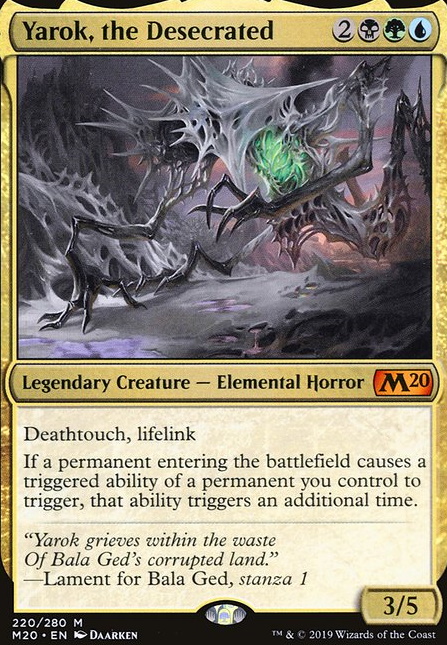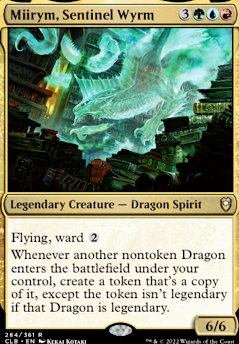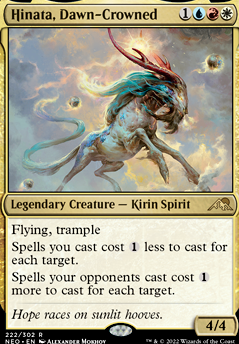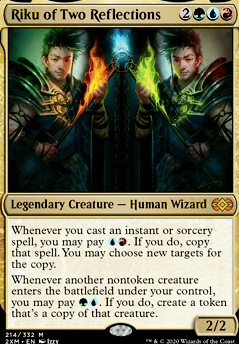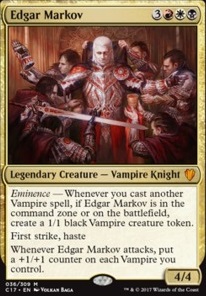Reclamation Sage: When Reclamation Sage enters the battlefield, we can destroy target artifact or enchantment. We can copy this trigger with Yarok, the Desecrated as well as other cards in the deck. As it is a creature, we can recur it quite easily from our graveyard and we have the ability of fetching Reclamation Sage from our library to the battlefield with Woodland Bellower. The majority of our spot removal is represented by our creatures entering the battlefield. Reclamation Sage is our first example, and definitely not our last.
Spellseeker: When Spellseeker enters the battlefield, we may search our library for an instant or sorcery card with converted mana cost two or less, reveal it and put it into our hand. Admittedly, we do not have a lot of instant and sorcery cards with converted mana cost two or less. However, the spells we do have that fit this category are very powerful: a tutor, targeted permanent removal and mass nonland permanent bouncing. Demonic Tutor puts any card from our library into our hand. Assassin's Trophy destroys any permanent an opponent controls. Cyclonic Rift does, well, overloaded Cyclonic Rifty things. These are the preferred targets for a Spellseeker trigger. Additionally, Essence Flux and Siren's Ruse were added in place of Displace and Ghostly Flicker from the original construction of this deck in order to be fetched-out by Spellseeker if needed. Either of these spells can blink one of our creatures in order to reap the benefits of some enter the battlefield triggers.
Grave Titan: Grave Titan is one of our best creatures to curve into after casting Yarok, the Desecrated. If this scenario transpires, then we net five bodies with total power and toughness of 14 for just . As a bonus, Grave Titan also triggers when it attacks, creating more zombie creature tokens. Grave Titan can amass a high number of zombies in a short amount of time, particularly if Yarok, the Desecrated or any other of our trigger copiers are on the battlefield under our control.
Plaguecrafter: When Plaguecrafter enters the battlefield, each player has to sacrifice a creature or a planeswalker (waving fist in the air and shouting, Sigarda, Host of Herons!!). Each player who can't discards a card. Here's a great piece of removal that can dance around hexproof, shroud, protection and indestructible. We have many small creatures in our deck, including several ways to create creature tokens. It will not be a burden to sacrifice multiple creatures if we have Yarok, the Desecreated, Panharmonicon and/or Strionic Resonator on the battlefield under our control when Plaguecrafter hits the 'field. Removing multiple creatures from our opponents' battlefield for is great value.
Woodland Bellower: With Yarok, the Desecrated or any other way to copy a triggered ability, Woodland Bellower can ramp us ahead of our opponents big-time. Imagine this scenario: We curve into Woodland Bellower and cast it the turn after casting Yarok, the Desecrated. When Woodland Bellower enters the battlefield, its enter the battlefield trigger triggers an additional time because of Yarok, the Desecrated. We search our library for two nonlegendary green creature cards with converted mana cost three or less and put them onto the battlefield. We select two of the following creatures: Farhaven Elf, Elvish Rejuvenator, Springbloom Druid, Risen Reef or Coiling Oracle. Then these two creatures enter the battlefield, and their enter the battlefield triggers trigger an additional time. We can easily net two creatures and four basic lands by casting Woodland Bellower in this fashion. Do we want to cast something the same turn? We can substitute one of the previously mentioned creatures with Lotus Cobra and reap the benefits of four mana of any color(s) we desire. Or maybe we can play some fetch lands from our graveyard. Ramunap Excavator and Dryad of the Ilysian Grove or Wayward Swordtooth can help with that. Do we want our hand replenished? Maybe we fetch-out Eternal Witness and Llanowar Visionary. Woodland Bellower is an engine of value in this deck.
Ulvenwald Hydra: Ulvenwald Hydra is another fantastic creature to curve into after casting Yarok, the Desecrated. If this scenario transpires, Ulvenwald Hydra will fetch-out any two lands in our deck. Any.
Two. Lands. Unfortunately, they enter the battlefield tapped, but with the number of landfall-sensitive permanents we have in this deck, that's not an overburdensome hurdle to jump and merely provides additional value.
Elvish Rejuvenator: This elf druid from Core 2019 should get a little more love. When Elvish Rejuvenator enters the battlefield, we look at the top five cards of our library. We may put a land card from among them onto the battlefield tapped. Notice that the text does not say BASIC LAND. It says LAND CARD. As in, ANY LAND. Yes, the possibility exists that this enter the battlefield trigger whiffs, even though the deck is nearly 40% lands, which, percentage-wise, signifies that two out of every five cards are lands. We only need one in five. I like those odds.
Llanowar Visionary: What happens when Llanowar Elves and Elvish Visionary get together? Naturally, they produce Llanowar Visionary. Well, they weren't going to produce Elvish Elves!! Llanowar Visionary is the best from both of these worlds. It draws us a card when it enters the battlefield, like Elvish Visionary, and we can tap it for , like Llanowar Elves.
Solemn Simulacrum: I'm still pushing the nickname Melancholy Automaton, but it's a losing battle. Anyway, one of the most valuable spells in our format, Solemn Simulacrum fetches a basic land when it enters the battlefield and draws us a card when it dies. The ability to blink and recur Solemn Simulacrum makes it even more valuable, especially if Yarok, the Desecrated is on the battlefield under our control.
Avenger of Zendikar: Avenger of Zendikar can be a finisher in this deck, as both its enter the battlefield trigger and landfall abilities can be triggered additional times. Winning the game with an army of plants is not unreasonable considering the various ways to trigger Avenger of Zendikar's multiple triggers.
Acidic Slime: Here is a form of removal on the body of 2/2 ooze with deathtouch. When Acidic Slime enters the battlefield, we destroy target artifact, enchantment, or land. This becomes even more valuable if we are able to copy the trigger with Yarok, the Desecrated, Strionic Resonator or Panharmonicon. Blinking it. Copying it. Creating tokens of it. Acidic Slime is a powerfully versatile piece of recursive removal.
Uro, Titan of Nature's Wrath: Reaping the benefits of multiple Uro, Titan of Nature's Wrath's enter the battlefield triggers can get out of hand for our opponents very quickly. Each time Uro, Titan of Nature's Wrath enters the battlefield, we draw a card, gain three life and may put a land card from our hand onto the battlefield. Imagine if Yarok, the Desecrated, Panharmonicon or Strionic Resonator also is on the battlefield under our control. Just one of them equates to drawing two cards, gaining six life and putting two land cards from our hand onto the battlefield, for just . Even better, if we escape it from our graveyard by paying and exiling five cards from our graveyard, then we can do it all over again. If we time it correctly, we can always use Crystal Shard on Uro, Titan of Nature's Wrath and return it to our hand prior to its forced sacrifice, and STILL reap the benefits of its enter the battlefield trigger!!
End-Raze Forerunners: Here we have Craterhoof Behemoth lite. Actually, is End-Raze Forerunners in the same conversation as Craterhoof Behemoth? If the topic of the conversation is game-enders, then End-Raze Forerunners is worthy of discussion. For the same converted mana cost as Craterhoof Behemoth, he gives other creatures we control +2 +2, vigilance and trample until the end of turn. It's reasonable to assume that we will be able to copy this trigger at least once upon End-Raze Forerunners entering the battlefield. So what we're really looking at is a probable +4 +4, vigilance and trample for our other creatures. End-Raze Forerunners itself has haste, vigilance and trample on a 7/7 body. Yes, End-Raze Forerunners belongs in the conversation of game-ending creatures, but we'll always think of Craterhoof Behemoth first.
Risen Reef: Whenever Risen Reef or another elemental enters the battlefield under our control, we can look at the top card of our library and if it's a land card, we may put it onto the battlefield tapped. If we don't put the card onto the battlefield, we can put it into our hand. Basically, when Risen Reef enters the battlefield, the top card of our library either goes to the battlefield if it's a land or into our hand if it isn't. This is a great way to draw some cards or ramp-up our lands.
Sidisi, Undead Vizier: NOTICE: Sidisi, Undead Vizier can exploit herself when she enters the battlefield. When Sidisi, Undead Vizier exploits a creature, we can search our library for a card and put it into our hand. With a casting cost of , it is not optimal to sacrifice Sidisi, Undead Vizier to her own exploit trigger. There are a lot of dorks and token creatures that should be inundating our battlefield, and one of those creatures is much easier to sacrifice. A 4/6 body with deathtouch is strong. Having the ability to Demonic Tutor by sacrificing a creature when Sidisi, Undead Vizier enters the battlefield is strong. With Yarok, the Desecrated on the battlefield, exchanging a couple of scrub creatures for a couple of tutored cards from our library is really, really strong.
Eternal Witness: Eternal Witness is our ultimate graveyard recursion target, particularly if we can copy her triggered ability. If we can, then when Eternal Witness enters the battlefield we can return as many target cards from our graveyard as the number of times Eternal Witness triggered. Strong with the force, she is.
Necromancy: The long-winded text on this card can be dizzying. If we choose to cast Necromancy with flash, then we sacrifice it at the beginning of the end step. Or, we simply cast it during our main phase. When Necromancy enters the battlefield, if it's on the battlefield, it becomes an aura with "enchant creature put onto the battlefield with Necromancy." Then we can put a target creature card from a graveyard onto the battlefield under our control and attach Necromancy to it. When Necromancy leaves the battlefield, that creature's controller sacrifices it. WOTC!!! Let's try to dial this down a bit. If we cast Necromancy as though it had flash, we have it and the creature it targeted until the beginning of the next end step. If we cast Necromancy during our main phase, then we have it and the creature it targeted until either the creature or Necromancy leaves the battlefield. We can copy this triggered ability and recur multiple creatures. CAUTION: When Necromancy leaves the battlefield we lose all creatures recurred by it. The headache is worth playing it, trust me. The headache you have now after reading this card's description, maybe not.
Farhaven Elf: Farhaven Elf is a descendant of the classic Wood Elves. Instead of searching for a forest card as per Wood Elves's enter the battlefield trigger, we can search for any basic land with Farhaven Elf. Farhaven Elf has more than twice the number of targets Wood Elves would have in this deck. Due to this, Farhaven Elf is preferred over Wood Elves, particularly because we plan to recur, blink and copy the enter the battlefield trigger of this land-fetcher as much as possible.
Greenwarden of Murasa: This elemental from Battle For Zendikar is a hefty version of Eternal Witness. For we get a 5/4 body that allows us to return a card from our graveyard to our hand after it enters the battlefield. When Greenwarden of Murasa dies, if we exile it, we can return a card from our graveyard to our hand. Greenwarden of Murasa's second ability is situational, of course. There may be a need to return a card from our graveyard to our hand when it dies, so exiling it is preferable. However, stashing it in the graveyard for later recursion will allow us to recur another card upon Greenwarden of Murasa's return to the battlefield. Got that?
Phantasmal Image: Do you know what's better than the combination of all of our enter the battlefield triggers from all of our creatures? All of the enter the battlefield triggers from all of our creatures...plus one! When Phantasmal Image enters the battlefield, we may have it enter the battlefield as a copy of any creature on the battlefield. Unfortunately, it is also an illusion in addition to its other creature types and has "when this creature becomes the target of a spell or ability, sacrifice it." Phantasmal Image is fragile after it enters the battlefield, but that's okay with us. By the time we need to worry about the illusion part of this creature, we already would have reaped the benefit of its enter the battlefield trigger.
Venser, Shaper Savant: We can be tricky with Venser, Shaper Savant. Having flash and returning a target spell or target permanent upon entering the battlefield is what makes this human wizard so versatile. We must make an important distinction about Venser, Shaper Savant. If we return a spell to its owner’s hand, it’s removed from the stack and will not resolve. The spell isn’t countered; it just no longer exists. This works against a spell that can’t be countered. Granted, the spell is returned to its owner's hand, which means that the opponent can cast it again. Buying time can be valuable. Additionally, we can return target permanent to its owner's hand when Venser, Shaper Savant enters the battlefield. This is improved if we have Yarok, the Desecrated or an equivalent on the battlefield under our control.
Springbloom Druid: For the purposes of this deck, and its landfall-laden theme, Springbloom Druid may be the most valuable land-fetcher we have. When Springbloom Druid enters the battlefield, we may sacrifice a land. If we do, we search our library for up to two basic land cards and put them onto the battlefield tapped. This is a creature version of Harrow. Not only do we reap the benefits of two lands entering our battlefield, but we get a land into the graveyard. We have multiple ways of playing lands from our graveyard, so this is win-win!
Coiling Oracle: Coiling Oracle was coiling around oracles well before Risen Reef was raising reefs. Or something. Sure. Anyway, when Coiling Oracle enters the battlefield we look at the top card of library. If it's a land card, we put it onto the battlefield. If it's not a land, we put the card into our hand. So, basically, play a land or draw a card. Coiling Oracle is a great target for multiple triggers as we can ramp-up our lands and/or fill our hand with cards.
Hornet Queen: Under the right circumstances, Hornet Queen can bring with her a swarm of deathtouching and flying insect creature tokens that act as combat deterrents for our opponents, or an aerial assault squad. The 1/1 flying deathtouchers are very valuable as few opponents want to lose precious creatures to some stinkin' 1/1 bugs. As we are light in the air, Hornet Queen offers protection from any winged adversaries hiding in the clouds. With the ability to copy triggered abilities and the presence of blink and recursion in this deck, creating a vast army of insects is not unreasonable.
Rune-Scarred Demon: Do you know what's better than a 6/6 flying demon that when it enters the battlefield we can Demonic Tutor? How about a 6/6 flying demon that when it enters the battlefield we can Demonic Tutor multiple times? Yarok, the Desecrated, Panharmonicon and Strionic Resonator approve.
Ravenous Chupacabra: When Ravenous Chupacabra enters the battlefield we can destroy target creature an opponent controls. Notice the text. It says DESTROY TARGET CREATURE. It doesn't say destroy target NONBLACK creature. It doesn't say destroy target NONTOKEN creature. It doesn't say destroy target NONLEGENDARY creature. Destroy. Target. Creature. The 2/2 body is weak at , but its trigger is strong. It's a trigger that we can, and will, copy. Destroy. Any. Creature. That is all.
Mulldrifter: Casting Mulldrifter for will be as rare as winter roses for this deck, particularly with the amount of recursion we have throughout this list. When Mulldrifter enters the battlefield, we draw two cards. We will pay Mulldrifter's evoke cost of and if we have Yarok, the Desecrated or Panharmonicon on the battlefield under our control, we're essentially drawing four cards for . Four cards. Three mana. I'm in!
Craterhoof Behemoth: The show-stopper. The curtain-caller. The walk-off. Craterhoof Behemoth is a finisher. This is the Mariano Rivera of our deck. We set-up the game and 'field, Craterhoof Behemoth finishes it. When Craterhoof Behemoth enters the battlefield, creatures we control gain trample and get +X/+X until end of turn, where X is the number of creatures we control. With a plethora of ways to create creature tokens, Craterhoof Behemoth will almost always have an army awaiting is arrival. Our ultimate finisher can be an army himself if targeted with a kicked Rite of Replication. That's six 35/35 hasty tramplers!
